Caillou is one of the most popular children's animation shows in Canada, and simplicity has been its hallmark, from its visual style - traditional 2D - to the show's premise: the ordinary life of a four-year-old boy. Currently, the producers are busy revamping the show for this fall's season on PBS in the US and on Teletoon Canada. A look behind their animation process reveals that a new 2D digital process will allow Cookie Jar Entertainment (www.cinar.com/ the show's production company, to bring production back from overseas and keep it in Canada, plus allow them more flexibility with the plot and visual aesthetic. Best of all, says executive producer Lesley Taylor, "I love not spending money on the things that don't get on the screen."
This show, and the others highlighted below, illustrates the continuous flux of the producer-vendor relationship, the impact of FTP sites on the animation process, and the enormous research put into attracting the demographic, in this case some very particular three to five year olds.
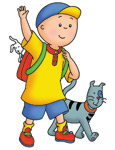
The animation for Caillou is handdrawn and then imported into Flash. Backgrounds are created in Photoshop.
|
Originally, there were two half-hour versions of Caillou (which means "little pebble" in French), an all-animation one in Canada and a combined animation/live action version for PBS because of its slightly longer broadcast window. Research done in Chicago and New York uncovered several things. One, the kids thought the live action parts were commercials. Two, they loved Caillou's perfectly normal family who spend all their time focusing on him. New season episodes, then, will be solely animation and include some parenting techniques. The plot will be more aspirational, giving Caillou and his creators more leeway with daydream scenarios.
The switch this season to 2D digital, says Taylor, was for "control of the product. Before, part of the shows were sent to Taiwan. We also have a lot of drawings. We're actually doing [much of] Caillou in [Macromedia] Flash, so a lot of the drawings are scanned from previous series. We have a lot of what would be called 're-use': it's already been animated. The idea is to make it, obviously, less expensive to produce, to keep it all in Canada where we can access funding for it, keep control of it, to have the show look the same as the previous series."
Using Flash is a technique that's worked. "Flash can manipulate existing drawings," says Taylor. "It can make them smaller, bigger... it could flip them. It used to be we'd get a video of Digi Beta of the show that would or would not arrive, depending on shipping. And now we go to Web site links and we just look at a whole film for mix approval. It's not television size, it's 6-inches across, but there's no more distance. There's still time differences but distance is gone. And we're getting more and more digital in how we work with FTP sites and artwork," she says. "We still want the handdrawn component of it, but there's less of that and I'm not paying customs anymore. I love that I'm not paying shipping."
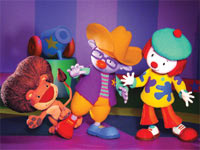
JoJo's Circus is animated by Cuppa Coffee in Toronto and uses a stop-motion style to tell the tale of a little girl who lives in a circus town.
|
Animation is now being handdrawn or created digitally, then imported in Flash; backgrounds are created in Adobe Photoshop on Mac G5s. Their animation pipeline is a cyberspace chainlink of vendors: Cookie Jar (Montreal) writes the scripts. Storyboards and the animatics/leica reel come from Guilty Kiwi (Ottawa) where the director is based. Flash animation is done at Pip (Ottawa). English voices are recorded and edited at Technicolor (Montreal). The French dub will be done in either Toronto or Montreal. Post is done at Technicolor (Toronto). Taylor is part time in Ottawa and Montreal. It takes about four months to produce an episode from script to delivery.
"I never quite know where I'm waking up," she says. Cookie Jar itself, only a year old and built from the remnants of Montreal-based Cinar, is spread out. The main office is in Toronto, Taylor's boss is in Los Angeles, the head of licensing is in Rhode Island, there are staff in Tokyo and salespeople in London and Paris. "The managing of the actual show is simpler because we're not in the Far East. If you say that you want a Charlie Chaplin walk and you send that over to China, they have no idea what you're talking about," she says.

Dora the Explorer airs on Nick Jr. Elements of 3D make their way into the primarily 2D program.
|
STOP MOTION CIRCUS JoJo's Circus, animated by Cuppa Coffee (www.cuppacoffee.com/) in Toronto, one of the largest stop-motion animation studios in North America, is a half-hour show that will begin its third season this fall on Playhouse Disney, the morning children's programming block on the Disney Channel. NYC's Cartoon Pizza (www.cartoonpizza.com/) the creators, sold it to Disney who selected the stop-motion style. The story focuses on a little girl living in a circus town. She learns life lessons and tries to keep everyone energized, including the preschoolers at home.
"The story has to be engaging right off the bat," says animation director Tim Snyder, referring to the specific challenges of attracting the pre-school audience. "We'll add in whatever kind of flash and sparkle we can to catch their attention here and there but it has to come from the story. JoJo will talk to the camera and ask for responses and tell the kids to get off the couch and jump around. When we first started the show my kids were the perfect demographic,, so I brought home animatics - simple storyboards set to the voice. No music, no sound effects, very dry but it gives you an idea of the story and the timing of things. They were answering, they were jumping up, they were talking to the television before any of the animation or special effects or anything came on board."
Stop motion, and its tactile look of toys that came to life, is a good hook for the audience, says Snyder. Scripts come from Cartoon Pizza; everything is posted on the Internet for approvals. Cuppa Coffee designs are handdrawn, scanned in and colored on the computer, then storyboards are handdrawn again, married to voice records and turned into animatics, which are shipped to New York and Los Angeles for approvals. More than 100 people at Cuppa Coffee alone work on building models and sets the traditional way with saws and drill presses. The animation is handled much like a live shoot with lights, animators and grips on set. In compositing, they remove the rigs that hold the puppets up, add backgrounds and add lipsync, which is mostly done with Photoshop. Compositing is done in Adobe After Effects on Mac G4s and G5s and editing is done in Apple Final Cut Pro. Chris Morris is the post supervisor. It takes about a six months to complete an episode.
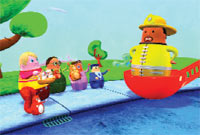
Higglytown Heroes combines 3D animation via Maya 6 with 2D flat animation created in Flash.
|
A challenge is the integration of special effects, like water effects, sparkles or fireworks, and 3D elements that have been added for a better look or quicker production result. In one episode, "Cuckoo Forest," a lot of dancing birds needed to be dropped into the scene. The bird puppet was too small, difficult to animate and hard to replicate, so a 3D model was created in Alias Maya. The trick was blending the different techniques - stop motion and 3D, - into one cohesive look. Another challenge - mismatches between size and scale - is solved with camera tricks. Last season they wanted eight clowns coming out of a car but not even one of the puppets fit in the actual car. Instead, the animators shot them separately bluescreen and put them together in the compositing suite.
ANIMATED HEROES Wild Brain in San Francisco created the half-hour Higglytown Heroes, which premiered in 2004 on Playhouse Disney. The show is actually two 11-minute cartoons with a civics theme, illustrating how the world works for little kids with different guest star heroes, from the plumber to grandma. The style is mostly 3D though fantasy segments are 2D flat animation done in Flash.
"I think [the preschoolers] really respond to 3D," says Denis Morella, the series' co-creator and director, with George Evelyn. "The characters are matroichka dolls; they look like toys. The animation has a quaint feel to it, almost like stop motion. It's not very complicated. It's bright colors, we try to keep the scenes very clean and neat with not a lot of clutter behind them so it's a clear read for the audience."
Adds editor Alex Hauser, "We have a whole system, the Higgly way, of putting a story together so that all the editors who work on the show know that no one shot should ever drop below 35 frames long because it's for three to five year olds and there's no need to do quick cuts. We also try to cap the number of shots per segment at 115. A lot of us, particularly in editorial, come from a commercial background where you're supposed to be pushing and pushing it and we have to really think about it - how would a three year old react to this shot?" Evelyn points out the "see and say" rule: if you see it on screen, the voiceover must say it.
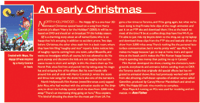
An early Christmas
|
The process starts with pencil on paper, goes into Photoshop for 2D study, then to Alias Maya for modeling and texturing. To keep the budget down, a lot of background houses are 2D elements mapped onto 3D structures. The main animation tool is Maya 6, and the compositing tool is After Effects 5.51 running on PCs. Dialogue is recorded at Soundworks Studio in North Hollywood. Wild Brain editors work in three Avid Media Composer Adrenaline suites that are the show's foundation, where directors look at every pass and then parcel it out to various overseas vendors. The edit suites run 21 hours a day, with assistant editors importing shots all night long so editors and directors can look at layout, animation and lighting passes the next day.
With scattered vendors, an efficient pipeline was developed to eliminate all linear tape. This has cut the show's total editing time in half, says Hauser. The editors get everything via DVD data disk, FTP or rsync server, a live-automated means to transfer data to and from each particular vendor. "The fact that we don't have to digitize DATs at a linear speed is an enormous timesaving," he says. Clients and vendors access scenes and sequences via QuickTime movies with burnt in timecode running over a bonded T1 line. It takes about four months to produce an episode.
THEY DID IT! Nick Jr. supervising producer Jeff DeGrandis says Dora the Explorer, on since 2000, is the hardest show he's ever produced. Every show has a hit list, an 11- to 12-point agenda of "must haves" from problem solving to body kinesthetics. Nick Animation has created 100 episodes (plus one-hour specials on DVD) that air for an hour on Nick Jr. The show is mostly 2D, but 3D elements find their way in. The character "Backpack" and his contents are created in After Effects, adding a new dimension and flexible way of controlling scene timing.
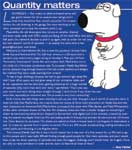
Quantity matters
|
Nick Animation creates the storyboards, up through the model pack, and puts it all in a box with the exposure sheets showing how the characters move. They then ship it to Saeron in South Korea, which does the animation. It takes about nine months to complete an episode. DeGrandis' job is to foster communication in the production triangle, from Nick's Burbank-based designers to Nick's New York writers and post people to the South Korean animators.
The trick to reaching the young audience is "reverse engineering of the education that you've gotten on other shows so we can build it for what we have now. We're constantly showing and reminding them that 'we have to go here,'" he says. "Every show has multiple challenges but our biggest is doing the breakout games where the child has to choose and decide where we're going to go. Those are very hard to do. The key in these shows is we have to travel with the Dora and Boots characters. We can't leave them. Dora is the one that commands us what to do. When she says jump, we jump and when she says clap, we clap. And then she wants it louder. The hardest thing is staying with her and Boots and interacting properly to achieve the goal that's been set up for us, and doing it so it feels like we're with her participating in the clearest way possible so no one is lost and we did it together."